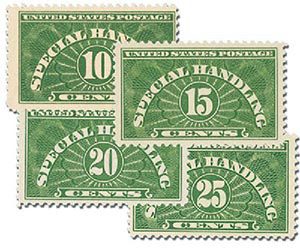On April 11, 1925, the US Post Office issued its first Special Handling stamp, #QE4.
The US Postal Service Act of 1925 clarified what made up the different classes of mail. Everything that did not fall into the first two classes of mail (written matter and periodical publications) was divided by weight. If it weighed less than eight ounces, it was third class, and if it weighed eight ounces or more, it was fourth-class mail.
The same Act provided for a special handling stamp of the 25-cent denomination to be produced. The 25-cent special handling stamps were only printed on flat plate presses and used the “wet” method (the paper was damp when the image was transferred). One difference between wet and dry printing was that wet printings weren’t as sharp in detail. They also have a dull, rough surface as compared to a hard, smooth sheen. The gum is thicker and smoother in wet printings, and the stamps are often slightly smaller in flat plate presses. This is because the paper shrinks slightly as it dries.
The first Special Handling stamp, #QE4, was issued on April 11, 1925. When added to an item that carried regular fourth-class postage, this stamp allowed the item to be handled as first-class mail.
The terms of the Postal Service Act were a little confusing. It was called “special handling,” which was often confused with “special delivery.” But, the “delivery” part was used only in regards to the special handling fee, and not for a different delivery schedule than first class mail. Instead, the Act was referring to the different types of items that might be mailed under that classification, such as live animals. It even specifically mentioned baby alligators!

The increased speed of delivery these stamps offered was important at the time when America was a rural, agricultural society. Parcels often contained live animals like baby chicks and alligators. With the slower parcel post service, the animals might die before being delivered. Collecting the extra fee in the way of a Special Handling stamp helped the post office pay for the added expense of faster delivery.
Three years later, 10¢, 15¢, and 20¢ denominations were issued to cover the revised rates that went into effect in July 1928. The stamps were later given their Scott numbers according to their denominations, which is why the first stamp is designated #QE4. Special Handling stamps were withdrawn from sale in post offices on October 24, 1947.
| FREE printable This Day in History album pages Download a PDF of today’s article. Get a binder or other supplies to create your This Day in History album. |
Discover what else happened on This Day in History.







Wow baby alligators…
I KNOW. ALLIGATORS. I dont ever want to hear my postman complain about delivering bees again! I will share this with him!
… and live bees!
This is one of the most fascinating and diverse of all the U.S. stamp issues. The 1928 stamps were recently discovered to have been printed on “Special Booklet Paper” and are now listed as QE1b, QE2b and QE3b in the 2020 Scott Catalog. The later printings, both wet and dry paper varieties of the 10¢ & 15¢ stamps,
were removed from sale on Sept. 11, 1959. See: American Philatelist, Nov. 1959, p. 88. Well done! Live chicks and baby alligators!
Different stamps with an interesting background ! Thanks Mystic for the update !
Great story. Bees and chickens I heard of but not gators.
Pay extra for quick delivery? Hello Amazon Prime!
The color and engraving strongly echo the designs of paper money.